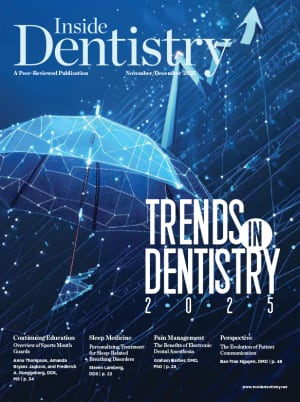Sagittal Analysis Enhances Restorative Treatment Planning
Integrating CBCT into routine diagnostics can improve dentists’ understanding of underlying skeletal discrepancies
As a restorative dentist, I approached all of my full-mouth rehabilitation cases with a facially generated treatment planning mindset-always beginning with the placement of the upper incisors in relation to the face. In my planning, I carefully considered the vertical and transverse dimensions; however, I spent surprisingly little time evaluating the sagittal dimension. After a decade in restorative dentistry, I returned to orthodontic residency, and now, as a practicing orthodontist, I see every treatment plan through the lens of skeletal and dental relationships in the sagittal dimension. What was once an overlooked area in my rehabilitation plans has become a fundamental pillar of my diagnostic process.
Although orthodontists are trained to evaluate and manage sagittal discrepancies as a core part of treatment planning, this perspective is often underemphasized in restorative dentistry. Looking back, I realize that having a better understanding of the sagittal relationship, including how the maxilla and mandible relate to one another and how dental compensations can mask underlying skeletal imbalances, would have enhanced my ability to treatment plan complex restorative cases and collaborate more effectively with specialists.
For example, incisor proclination is a sagittal diagnosis. When incisors are excessively proclined or retroclined, their line angles shift, altering the way that light reflects off of their surfaces and impacting their esthetics. This can affect the perception of tooth width and symmetry. Beyond appearance, the stability of restorations is closely tied to the positioning of the incisors within the bone. Incisors that are positioned too far labially or lingually may compromise bone support, and that can lead to long-term instability. Moreover, the position of the incisors affects occlusal function and load distribution, which can have an impact on the longevity of both natural and restored teeth.
A common example of restorative instability due to sagittal discrepancies occurs in cases where patients present with a Class II skeletal relationship, but the teeth appear to be in a Class I dental relationship due to dental compensations. In such cases, deepening the bite through restorative treatment without addressing the underlying skeletal discrepancy can lead to excessive overloading of anterior restorations, increased wear, and functional issues, such as fremitus or mobility. The posterior occlusion may also lack stability, which can lead to long-term relapse or temporomandibular joint discomfort. Recognizing these factors earlier in my career would have helped me deliver more stable and functionally sound rehabilitations.
With cone-beam computed tomography (CBCT) imaging beginning to replace the traditional full-mouth series of radiographs as the gold standard in restorative dentistry, evaluation of the sagittal dimension is becoming more accessible than ever. CBCT provides a three-dimensional view of skeletal and dental structures, which facilitates a more precise assessment of maxillomandibular relationships. When CBCT is integrated into routine diagnostics, it can enable restorative dentists to better understand underlying skeletal discrepancies.
This perspective is not meant to diminish the comprehensive care that restorative dentists provide but rather to highlight an opportunity for growth. Incorporating sagittal analysis into restorative treatment planning, even at a basic level, can lead to more predictable outcomes, improved occlusion, and enhanced long-term stability for our patients. Furthermore, if restorative dentists broaden their diagnostic lens to include the sagittal dimension, they can collaborate more effectively with orthodontists to create truly comprehensive, functionally harmonious, and esthetically optimized treatment plans.
About the Author
Courtney Lavigne, DMD, is a board-certified orthodontist and an accredited member of the American Academy of Cosmetic Dentistry. She maintains a private practice in Rhode Island.
